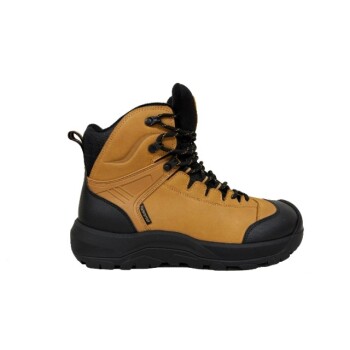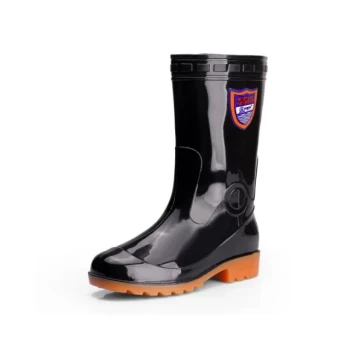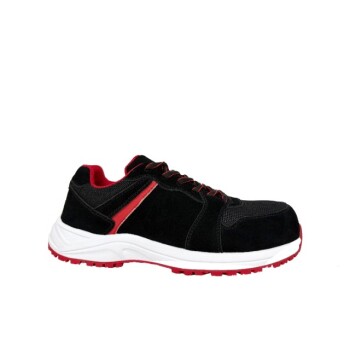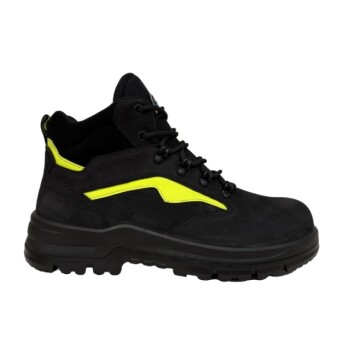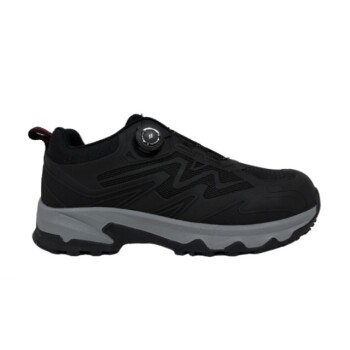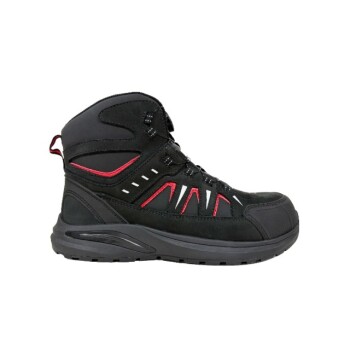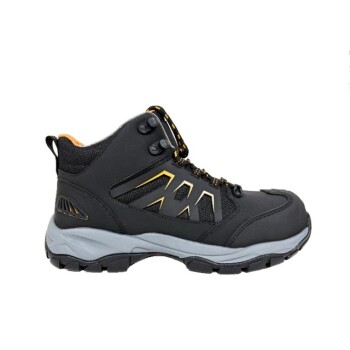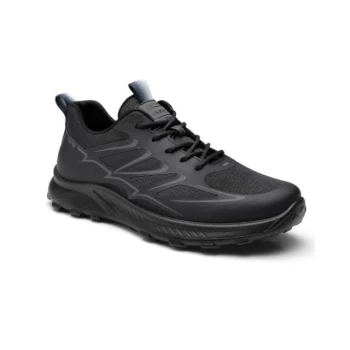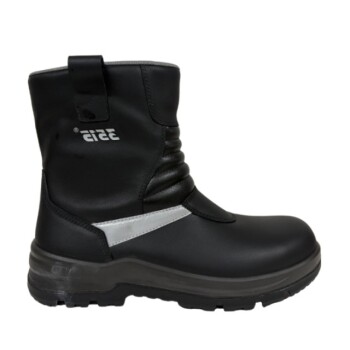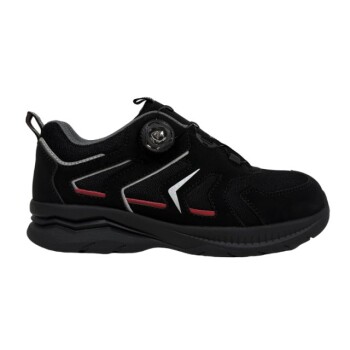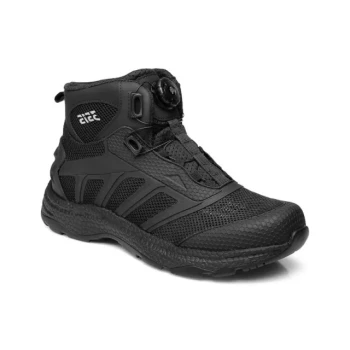The short answer is physics. When snow enters your boots, your body heat is consumed to melt it from a solid to a liquid. This process, known as a phase change, actively pulls a significant amount of warmth directly from your feet, leaving them feeling much colder than the air temperature would suggest.
Your feet getting cold is rarely due to a single failure, but a breakdown in a system of heat management. While snow entry is a critical problem, true warmth comes from controlling heat loss through moisture, conduction, and circulation.

The Physics of Cold Feet: A Systems Approach
Keeping your feet warm during winter cycling isn't just about insulation; it's about understanding and defeating the multiple ways your body loses heat. Cycling is a unique challenge because your feet are relatively static compared to running, generating less internal warmth.
The Moisture Problem: Internal and External Threats
Moisture is the primary enemy of warmth. Once your socks or boot liners are wet, they conduct heat away from your skin with alarming efficiency.
The most obvious source is external, such as snow entering the top of your boot. As mentioned, the energy required to melt this snow is stolen directly from your foot.
However, an equally significant threat is internal: sweat. Over-insulating your feet can cause them to sweat, creating the same heat-sapping damp environment as melted snow.
Conduction: The Silent Heat Thief
Conduction is heat loss through direct contact. In winter cycling, the most significant point of conductive heat loss is the connection between your shoe and your pedal.
Metal pedals are a major culprit, conducting heat away from your feet up to 1000 times faster than plastic or composite pedals. This turns your pedals into powerful heat sinks, constantly draining warmth from the soles of your feet.
Circulation: Your Body's Internal Heater
Your circulatory system is your body’s heating system. If your core or legs get cold, your body instinctively reduces blood flow to your extremities—your hands and feet—to conserve heat for your vital organs.
This is why inadequate leg insulation is a common cause of cold feet. Even with the best boots, if the blood arriving at your feet is already cold, they will never feel warm.
Generation: The Impact of Movement
Muscle movement generates heat. The rigid soles found on many cycling shoes restrict the small muscle movements in your feet.
More flexible soles allow for more foot flexion during pedaling and walking. This subtle movement generates a small but crucial amount of internal heat, helping to counteract the constant heat loss to the environment.
Building a Complete Defense System
To achieve truly warm feet, you must address each method of heat loss systematically. Think of it as creating layers of defense.
Step 1: Seal the Entry Points
Your first priority is to create an impenetrable barrier against snow.
- Pants Over Boots: The simplest method is to ensure your pant legs fit securely over the top of your boots, not tucked inside.
- Gaiters: For deep snow or extreme conditions, a dedicated gaiter is the most effective solution, creating a complete seal around your lower leg and boot.
- Integrated Closures: Many winter-specific boots have built-in gaiters or draw-cord closures at the cuff to seal out snow.
Step 2: Insulate Your Legs and Core
Maintaining blood flow is non-negotiable. Layer your legs according to the temperature to keep warm blood circulating to your feet.
- Down to -5°C (23°F): A single layer of thermal long johns or cycling tights is often sufficient.
- -5°C to -20°C (23°F to -4°F): Use layered stretch fleece tights, often with a wind-resistant front panel.
- Below -20°C (-4°F): Heavy fleece or soft-shell pants with robust wind protection are necessary.
Step 3: Disrupt the Pedal Connection
You must break the conductive link between your foot and the pedal.
- Use Plastic/Composite Pedals: This is the most effective change you can make to combat conductive heat loss.
- Add Insulated Insoles: A thermal insole, especially one made of wool or closed-cell foam, adds a critical insulating layer.
- Create a Barrier: In a pinch, you can place a simple barrier, like a piece of a plastic credit card or folded-up aluminum foil, between your boot's outer sole and the liner, directly under the cleat area.
Understanding the Trade-offs
There is no single perfect solution, and optimizing for warmth often involves balancing competing priorities.
Over-Insulation vs. Moisture Management
The instinct to wear more or thicker socks can be a mistake. Over-insulating can restrict blood flow and, more importantly, cause your feet to sweat. A slightly damp foot from sweat will become a dangerously cold foot as that moisture cools you down.
Stiffness vs. Warmth
Stiff-soled cycling shoes are designed for maximum power transfer to the pedal. However, this stiffness prevents the foot from flexing, reducing internal heat generation. A more flexible winter boot or flat-soled shoe will be inherently warmer at the cost of some pedaling efficiency.
How to Apply This to Your Ride
Use this framework to diagnose your specific issue and choose the right intervention.
- If your primary problem is wet feet from snow: Your immediate focus should be on sealing the boot-pant interface with gaiters or proper pant layering.
- If your feet get cold on dry but frigid days: Your issue is likely conduction. Switch to composite pedals and add thermal insoles to your boots.
- If your feet feel numb and cold despite thick, dry boots: The problem is almost certainly circulation. Add more insulation to your legs and core to keep warm blood flowing.
By treating foot warmth as a complete system, you can effectively diagnose failures and ensure your feet remain comfortable on even the coldest rides.
Summary Table:
| Heat Loss Factor | Key Insight | Primary Solution |
|---|---|---|
| Snow Entry (Moisture) | Melting snow consumes foot heat. | Seal boot tops with gaiters or pants. |
| Conduction | Metal pedals act as powerful heat sinks. | Switch to plastic/composite pedals. |
| Circulation | Cold core/legs reduce blood flow to feet. | Insulate legs and core appropriately. |
| Generation | Stiff soles reduce heat-generating movement. | Consider more flexible footwear. |
Stop the Chill at the Source with Professional-Grade Footwear
Are you a distributor, brand owner, or bulk client struggling with cold-weather performance in your cycling product line? The science is clear: effective heat management requires a holistic approach, starting with the right footwear.
As a large-scale manufacturer, 3515 produces a comprehensive range of performance boots and shoes designed to combat the specific challenges of winter cycling. Our production capabilities encompass all types of shoes and boots, engineered with:
- Integrated Sealing Systems to prevent snow and moisture entry.
- Optimized Sole Constructions that balance power transfer with flexibility for internal heat generation.
- Compatibility with thermal insoles to disrupt conductive heat loss.
Let us help you equip your customers for ultimate comfort and performance. Contact our team today to discuss how our manufacturing expertise can become your competitive advantage.
Get a Quote for Your Winter Cycling Footwear Needs
Visual Guide
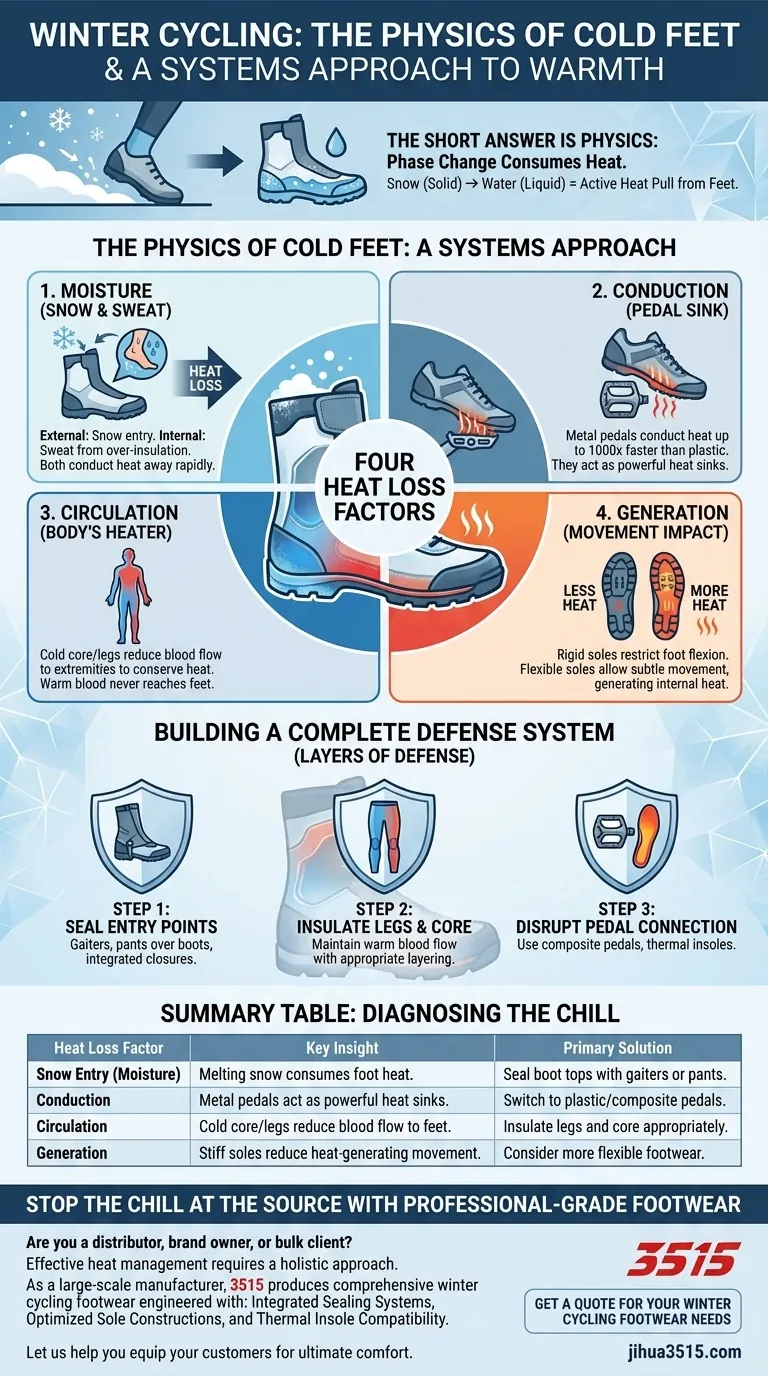
Related Products
- Premium Insulated Safety Boots and Shoes for Wholesale & Bulk Orders
- Safety Footwear Wholesale Manufacturer for Custom OEM/ODM Production
- Durable Waterproof Rain Boots | Custom Manufacturer for Wholesale & Brands
- Premium Suede Sport Safety Shoes for Wholesale & Bulk Orders
- Wholesale Customizable Safety Boots Durable & Protective Footwear Manufacturing
People Also Ask
- Why is keeping feet warm important during winter work? Protect Your Health and Safety on the Job
- What is Thinsulate and how does it function in insulated boots? Achieve Superior Warmth Without Bulk
- What additional protective footwear feature might be beneficial for construction workers in cold climates? Choose Composite Toe for Superior Warmth
- How does Thinsulate lining work in safety footwear? Stay Warm and Dry in Any Condition
- What is the best way to protect feet from frostbite in winter? A Complete System for Dry, Warm Feet
